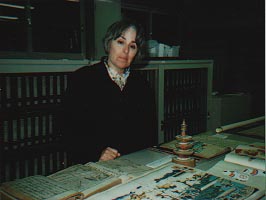October 20 - November 9, 1998
By Charlotte Cohen
|
Time to remember The thoughtfulness of others Kochirakoso
Preparation for the exchange was enjoyable in itself. Through conversations and correspondence with Marian Horner and former Horner Fellows, I became more aware and appreciative of the unique history and mission of the fellowship. A whole new world unfolded before me as I read, watched films, surfed the Internet, listened faithfully to a "Berlitz Live" Japanese language CD and began corresponding with Professor Tsutomu Shihota and Mizue and Yoshitake Yamabe (host family to four previous Horner Fellows). Japan Library Association Conference My arrival in Japan began with an overnight stay in Tokyo with ASU colleague Katsuko Hotelling. The next morning it was our good fortune to see Mount Fuji as we sped by on a shinkansen (bullet train) bound for Akita and the 1998 Japan Library Association conference. At the conference, there were many opportunities to meet librarians from all over Japan and I learned that we are addressing many of the same issues. I also learned that Japanese libraries have a unique history and distinctive issues of their own. After the conference we toured Akita Prefecture visiting a number of historic sites, hot springs and an onsen as we toured the countryside during harvest season. In Osaka, I was welcomed by Professor Shihota and my host family the Yamabes. Through their generous hospitality I was privileged to experience Japanese customs and culture in a very special way. Library Visits My itinerary included visits to nine libraries as well as sightseeing in Osaka, Kyoto, Nara and Himeji, Kamakura and Tokyo. Etiquette for library visits was interesting and certainly charming by American standards. Introductions would take place with an exchange of business cards (meishi). A brief conversation pertinent to the library and the fellowship would then take place as green tea (cha) was served. Gifts were exchanged followed by a library tour. An interesting impression that occurred in several libraries was the contrast between the old and the new --rare and ancient collections in modern, technological libraries. The extent to which automation and robotics are utilized in many of the libraries visited was fascinating. Efficient automated retrieval systems were used by circulation and/or reference service points to retrieve items from both open and closed stacks.
A delightful attribute of Japanese hospitality is the propensity to anticipate a guest's wishes and based on their interests to surprise them with something special. In this way, I experienced many delightful and unexpected adventures. Among those delightful and unexpected surprises was a congenial dinner party hosted by Mr. Kazumi Tominaga and Mr. Eiji Suzuki which not only provided the opportunity to make new acquaintances but also provided the opportunity to meet with Japanese colleagues who had visited Arizona in the past. Mr. Noritada Otaki's warm welcome my first evening in Japan and his gracious arrangement of an impromptu tour of the National Diet Library was very much appreciated. I shall long remember an evening visit and over-night stay at the temple home of Takashi Hirai, a friend and protégé of Professor Shihota. It was my privilege to share an evening meal, observe a Buddhist purification ceremony at the temple and participate in a tea ceremony at this home filled with harmony and kindness. Japan Library Association Partnership A primary focus of the sixth Horner Fellowship exchange was to explore the possibility of establishing a reciprocal exchange between librarians from Japan and Arizona. This had been an original aim of Dr. and Mrs. Horner. A meeting with Reiko Sakagawa, Secretary General of Japan Library Association was arranged by Professor Shihota at the JLA offices in Tokyo. Ms. Sakagwa responded positively to an informal invitation by AzLA President Louise Stephens to consider establishing an exchange. In April of 1999 JLA's Board approved and accepted a formal invitation from AzLA President Caryl Major to establish a partnership. Currently the Horner Fellowship Planning Committee and Mr. Toru Koizumi, Chair of JLA's International Relations Committee, are working together to plan an exchange for the year 2000 and beyond. Traveling to Japan as a Horner Fellow was a remarkable experience and I am grateful to Dr. and Mrs. Horner for their generosity in establishing this fellowship. Throughout my travels in Japan I was mindful of the hard work and dedication of colleagues on "both sides of the Pacific" who have made this exchange possible. A particular word of thanks must go to Tsutomu Shihota and the Yamabe family (Mizue, Yoshitake and Kenji) for their remarkable dedication over the years and for insuring the success of the fellowship. I would encourage any AzLA member interested in international librarianship to think seriously about applying for this unique and very enriching fellowship. |
